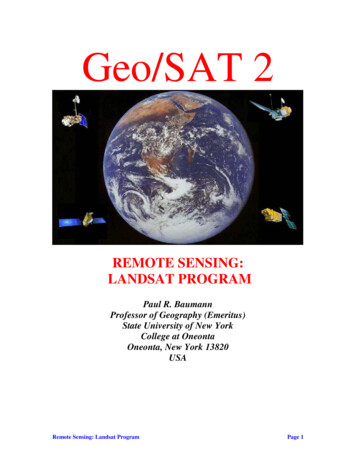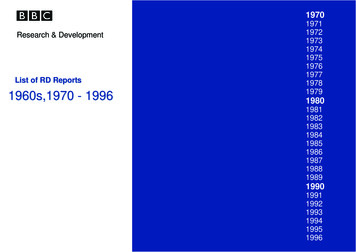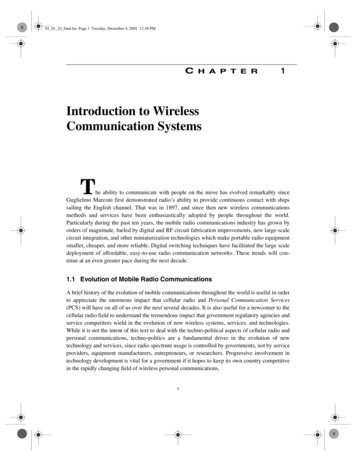
Transcription
Geo/SAT 2REMOTE SENSING:LANDSAT PROGRAMPaul R. BaumannProfessor of Geography (Emeritus)State University of New YorkCollege at OneontaOneonta, New York 13820USARemote Sensing: Landsat ProgramPage 1
FROM THE BEGINNING:FIGURE 1: Landsat Timeline.The Landsat program offers the longest continuous global record of the Earth's surface(Figure 1). It continues to deliver visually stunning and scientifically valuable images ofour planet. In 1975, NASA Administrator Dr. James Fletcher predicted that if one spaceage development would save the world, it would be Landsat and its successor satellites.Since the early 1970s, Landsat has continuously and consistently archived images ofEarth; this unparalleled data archive gives scientist the ability to assess changes in Earth’slandscape.“It was the granddaddy of them all (other satellite systems), as far as starting the trend ofrepetitive, calibrated observations of the Earth at a spatial resolution where one can detectman’s interaction with the environment,” Dr. Darrel Williams, the Landsat 7 ProjectScientist, states about Landsat.Landsat sensors have a moderate spatial-resolution. One cannot see individual houses ona Landsat image, but one can see large man-made objects such as highways. This is animportant spatial resolution because it is coarse enough for regional coverage, yetdetailed enough to characterize human-scale processes such as urban growth.“The Landsat program was created in the United States in the heady scientific andexploratory times associated with taming the atom and going to the Moon,” explains Dr.John Barker. In fact, it was the Apollo Moon-bound missions that inspired the Landsatprogram. During the early test bed missions for Apollo, photographs of Earth’s landsurface from space were taken for the first time. “This photography has been documentedas the stimulus for Landsat,” explains Dr. Paul Lowman, who proposed the terrainphotography experiment for the last two Mercury missions, the Gemini missions, and theApollo 7 and 9 missions.In 1965, director of the U.S. Geological Survey (USGS), William Pecora, proposed theidea of a remote sensing satellite program to gather facts about the natural resources ofRemote Sensing: Landsat ProgramPage 2
our planet. Pecora stated that the program was “conceived in 1966 largely as a directresult of the demonstrated utility of the Mercury and Gemini orbital photography to Earthresource studies.” While weather satellites had been monitoring Earth’s atmosphere since1960 and were largely considered useful, there was no appreciation of the Earth’s surfacefrom space until the mid-1960s.When Landsat 1 was proposed, it met with intense opposition from the Bureau of Budgetand those who argued high-altitude aircraft would be the fiscally responsible choice forEarth remote sensing. Concurrently, the Department of Defense feared that a civilianprogram such as Landsat would compromise the secrecy of their reconnaissancemissions. Additionally, geopolitical concerns existed pertaining to photographing foreigncountries without permission. In 1965, NASA began methodical investigations of Earthremote sensing using instruments mounted on planes. In 1966, the USGS convinced theSecretary of the Interior, Stewart L. Udall, to announce that the Department of theInterior (DOI) was going to proceed with its own Earth-observing satellite program. Thissavvy political stunt coerced NASA to expedite the building of Landsat. But, budgetaryconstraints and sensor disagreements between application agencies (notably theDepartment of Agriculture and DOI) again stymied the satellite construction process.Finally, by 1970 NASA had a green light to build a satellite. Remarkably, within onlytwo years, Landsat 1 was launched, heralding a new age of remote sensing of land fromspace.LANDSATS 1-3Landsat 1Landsat 1 was launched on July 23, 1972 (Figure 2). Initially the satellite was known asthe Earth Resources Technology Satellite (ERTS). It wasthe first Earth-observing satellite to be launched with theexpress intent to study and monitor our planet’slandmasses. To perform the monitoring, Landsat 1carried two remote sensing instruments: a camera systembuilt by the Radio Corporation of America (RCA) calledthe Return Beam Vidicon (RBV), and the MultispectralScanner (MSS) built by the Hughes Aircraft Company.The RBV was supposed to be the prime instrument, butthe MSS data were found to be superior. In addition, theRBV instrument was the source of an electrical transientthat caused the satellite to briefly lose altitude control. Itbecame necessary to shut down the RBV instrument inorder to maintain the operation of the satellite. Only asmall number of images were recorded using the RBV.FIGURE 2: Landsat 1 SatelliteThe MSS instrument was flown as the secondary and highly experimental instrument.“But once we looked at the data, the roles switched,” relates Stan Freden, Landsat 1Remote Sensing: Landsat ProgramPage 3
Project Scientist. In the foreword of the U.S. Geological Survey’s “ERTS-1 A NewWindow on Our Planet,” published in 1976, then-director of the USGS, Dr. V. E.McKelvey, wrote: “The ERTS spacecraft represent the first step in merging space andremote-sensing technologies into a system for inventorying and managing the Earth’sresources.” Landsat 1 operated until January 1978, outliving its design life by five years.The Landsat 1 MSS system acquired over 300,000 images providing repeated coverageof the Earth’s land surfaces. The quality and impact of the resulting information exceededall expectations.Landsat 2Landsat 2 was launched on January 22,1975 (Figure 3), two and a half yearsafter Landsat 1. The second Landsatwas still considered an experimentalproject and was operated by NASA.Landsat 2 carried the same sensors as itspredecessor: the RBV and the MSSsystems. The RBV instrument wasprimarilyusedforengineeringevaluation purposes and RBV imagerywas obtained, mainly for cartographicuses in remote areas. The MSScontinued to systematically collectimages of Earth. Despite having adesign life of one year, Landsat 2operated for over seven years. Finally in1982 it was decommissioned.FIGURE 3: Landsat 2 – Artist’s ViewLandsat 3Landsat 3 was launched on March 5, 1978(Figure 4), three years after Landsat 2. The thirdLandsat was still considered an experimentalproject and was operated by NASA until 1979.Because of the Landsat program’s technical andscientific success, it was declared operational in1979 and operational responsibility shifted fromNASA (a research and development agency) tothe National Oceanic and AtmosphericAdministration (NOAA), the agency chargedwith operating the weather satellites.FIGURE 4: Landsat 3 in the cleanroomRemote Sensing: Landsat ProgramPage 4
Landsat 3 carried the same sensors as its predecessor: the RBV and the MSS systems.However, the RBV instrument had an improved 30 m ground resolution and used twoRCA cameras which both imaged in one broad spectral band (green to near-infrared;0.505–0.750 µm) instead of three separate bands (green, red, infrared) like itspredecessors.The MSS continued to systematically collect images of Earth using four spectral bands. Afifth band, thermal infrared, was also part of the Landsat 3 MSS, but this band failedshortly after launch. In March of 1983, Landsat 3 was decommissioned.RETURN BEAM VIDICONThe RBV camera system was designed to obtainhigh resolution television pictures of the Earth.Three cameras were used to take picturessimultaneously in three different spectral bands.The cameras were similar except for the spectralfilters contained in the lens assemblies to provideseparate spectral regions. Camera 1 covered thevisible blue-green portion of the spectrum, Camera2 the visible orange-red portion, and Camera 3 thered-near-infrared portion. They were designatedBands 1-3.FIGURE 5: Three RBV Camera SystemThe three RBV cameras on Landsats 1 and 2 were aligned to view the same squareground area (Figure 5). The three Earth-oriented cameras were mounted on a commonbase, structurally isolated from the spacecraft to maintain accurate alignment. When thecameras were shuttered, the images were stored on the RBV photosensitive surfaces, andthen scanned to produce video signal output. Video data from the RBV were transmittedin both real-time and tape-recorder modes.On Landsat 3, two RBV cameras were used (Figure 6). The twocameras provided side-by-side images. Each camera operatedindependently allowing for single frame or continuous coverage.They each had the same broad-based spectral range (yellow tonear IR) at 505 to 750 nanometers. These changes were made toprovide increased ground resolution for mapping the Earth surface.The RBV camera systems on Landsats 1-3 failed to performsuccessfully and created electronic operational problems for thesatellites. The RBV systems were not used again.FIGURE 6: Two RBV Camera SystemRemote Sensing: Landsat ProgramPage 5
MULTISPECTRAL SCANNERThe MSS sensor (Figure 7) was a linescanning devices observing the Earthperpendicular to the orbital track. Thecross-track scanning was accomplishedby an oscillating mirror; six lines werescanned simultaneously in each of thefour spectral bands for each mirrorsweep (Figure 8). The forward motionof the satellite provided the along-trackscan line progression.The first five Landsats carried the MSSsensor which responded to Earthreflected sunlight in four spectral bands.On Landsats 1-3 these bands werenumbered 4-7 since the three RBVbands were 1-3 (Table 1). On Landsats4-5 the MSS bands were identified as 1FIGURE 7: Multispectral Scanner System 4. Landsat 3 carried an MSS sensor withan additional band, designated band 8,that responded to thermal (heat) infrared radiation.An MSS scene had an Instantaneous Field Of View (IFOV) of 68 meters in the crosstrack direction by 83 meters in the along-track direction (223.0 by 272.3 feetrespectively). To understand this concept, consider a single, rectangular ground point thatis 68 by 83 meters in size. The scan monitor sensor ensures that the cross-track opticalscan is 185 km (115 mi.) at nominal altitude regardless of mirror scan nonlinearity orother perturbations of mirror velocity.Crosstrack image velocity was nominally6.82 meters (22 ft.) per microsecond. After9.958 microseconds, the 83 by 83 meterimage has moved 67.9 meters. The sampletaken at this instant represented 15 meters(49 ft.) of previous information and 68meters (223 ft.) of new information.Therefore, the effective IFOV of the MSSdetector in the cross-track direction wasconsidered to be 68 meters whichFIGURE 8: Scan Track Directioncorresponds to a nominal picture element(pixel) ground area of 68 by 83 meters at the satellite nadir point. Using the effectiveIFOV in area calculation eliminates the overlap in area between adjacent pixels.Remote Sensing: Landsat ProgramPage 6
Table 1: Landsats 1-3 RBV and MSS Specifications.SatelliteSensorBand No.Wavelength (µm)Geo. ResolutionLandsats 1-2RBV10.48 to 0.5780 x 80m20.58 to 0.6880 x 80m30.70 to 0.8380 x 80m40.50 to 0.6056 x 79m50.60 to 0.7056 x 79m60.70 to 0.8056 x 79m70.80 to 1.1056 x 79mRBV10.505 to 0.7540 x 40mMSS40.50 to 0.6056 x 79m50.60 to 0.7056 x 79m60.70 to 0.8056 x 79m70.80 to 1.1056 x 79m810.4 to 12.6240 x 240mMSSLandsat 3The radiometric resolutions on the first three Landsats MSS bands 1-3 were 0-127 or 128discrete numerical levels. The resolution on the fourth band was 0-63 or 64 levels. Withrespect to a computer byte, a resolution of 0-127 required only 7 bits of an 8-bit byte. Aresolution of 0-63 took 6 bits. During this period a byte of 8 bits was not the computerindustry standard. In fact, the industry dominated by large mainframe companies such asIBM and Univac vacillated between a 7-bit byte and a 9-bit byte.LANDSATS 4-5Landsat 4Landsat 4 was launched on July 16, 1982 (Figure 9). The Landsat 4 spacecraft wassignificantly different than that of the previous Landsats. First, it did not carry the RBVinstrument. Second, in addition to the MSS sensor, Landsat 4 carried a new scanningsensor with improved spectral and spatial resolution. The new scanner could see a wider(and more scientifically-tailored) portion of the electromagnetic spectrum and could viewthe ground in greater detail. This new scanner was known as the Thematic Mapper (TM).Remote Sensing: Landsat ProgramPage 7
The Landsat 4 TM instrument had seven spectral bands.Data were collected from the blue, green, red, nearinfrared, mid-infrared (2 bands) and thermal infraredportions of the electromagnetic spectrum.Within a year of launch, Landsat 4 lost the use of two of itssolar panels and both of its direct downlink transmitters.So, the downlink of data was not possible until theTracking and Data Relay Satellite System (TDRSS)became operational; Landsat 4 could then transmit data toTDRSS using its Ku-band transmitter and TDRSS couldthen relay that information to its ground stations.FIGURE 9: Landsat 4When Landsat 5 became operational, Landsat 4’s functional Ku-transmitter was limitedto downloading acquired international data via the TDRSS. This arrangement continueduntil 1993, when Ku-band transmitter also failed on Landsat 4. Landsat 4 was kept inorbit for housekeeping telemetry command and tracking data (which it downlinked via aseparate data path, known as the S-band) until it was decommissioned in 2001.Landsat 5On March 1, 1984, NASA launched Landsat 5, the agency’s last originally mandatedLandsat satellite. Landsat 5 was designed and built at the same time as Landsat 4 andcarried the same payload: the MSS and TM sensors.In 1987, the Landsat 5 TDRSS transmitter (Ku-band) failed. This failure madedownlinking data acquired outside of the U.S. data acquisition circle (i.e., range of U.S.ground receiving antennas) impossible; Landsat 5 has no on-board data recorder to recordacquired data for later downlink.The MSS instrument was turned off in August of 1995. The TM instrument is still inoperation, nearly three decades after its planned design life. Data are regularly acquired atstations in the U.S. and Australia for entry into the U.S. archive. A number ofInternational Ground Stations download data for their local acquisition area.In November 2005, Landsat 5 TM operations were suspended after problems with thesolar array left the satellite unable to properly charge its on-board batteries. Workingtogether, USGS and NASA engineers were able to devise a new method of solar arrayoperations. And, on January 30, 2006 Landsat 5 resumed normal operations.THEMATIC MAPPERThe Thematic Mapper (TM) is an advanced, multispectral scanning, Earth resourcessensor designed to achieve higher image resolution, sharper spectral separation, improvedRemote Sensing: Landsat ProgramPage 8
geometric fidelity and greater radiometric accuracy and resolution than the MSS sensor.TM data are sensed in seven spectral bands simultaneously (Table 2). Band 6 sensesthermal (heat) infrared radiation. Landsat can only acquire night scenes in band 6. A TMscene has an Instantaneous Field Of View (IFOV) of 30 square meters in bands 1-5 and 7while band 6 has an IFOV of 120 square meters on the ground. The TM radiometricresolution is 0-255 or 256 discrete numerical levels. The MSS instruments on bothLandsat 4 and 5 also have radiometric resolutions of 0-255.Table 2: Landsats 4-5 MSS and TM Specifications.SensorMSSTMBand No.Wavelength (µm)Geo. ResolutionGreen Visible10.50 to 0.6082mRed Visible20.60 to 0.7082mNear IR30.70 to 0.8082mNear IR40.80 to 1.1082mBlue Visible10.45 to 0.5230mGreen Visible20.52 to 0.6030mRed Visible30.63 to 0.6930mNear IR40.76 to 0.9030mMid IR51.55 to 1.7530mThermal IR610.4 to 12.5120mMid IR72.08 to 2.3530mLandsats 1-3 were designed mainly to determine if satellites could provide an effectivemeans for observing, measuring, and analyzing conditions on the Earth’s surface.Emphasis was placed on developing a successful operating system that involved putting astable platform in space, testing and evaluating two different remote sensing instruments,and downloading the imagery from the instruments. Less emphasis was given to selectingthe spectral and spatial characteristics of the bands. Once Landsat 1 became operational,NASA provided imagery to several hundred scientists throughout the world. The imagerycame mainly from the MSS system and included not only digitally based photographs butalso the digital data downloaded from the system. These scientists, representing a widerange of disciplines, were to evaluate how effective the imagery might be in studying theEarth. To deal with the digital data, they needed to develop software that would allow theenhancement of the data, mathematically combining data from two or more bands, andclassifying statistically the data. This evaluation process was done during a time whenRemote Sensing: Landsat ProgramPage 9
mainframe computers dominated the digital world and computer graphics were barelyknown. The main graphics output device of the time was the line printer, which was goodfor printing numerical reports but very crude with respect to displaying imagery. Withinthe context of this environment, the scientists started identifying better spectral bandlevels and ranges and better spatial (geometric) resolution to study the Earth. This workculminated in the designing the Thematic Mapper.Table 3 identifies the main tasks that each band is especially adept at doing. Thesespectral bands were selected after reviewing the work done by the scientific community.Emphasis was placed on detecting various vegetation and water conditions.Table 3: TM Spectral Band Applications.BandPrincipal Applications1Coastal Water Mapping, Soil Vegetation Differentiation,Deciduous/Coniferous Differentiation2Green Reflectance by Healthy Vegetation3Chlorophyll Absorption for Plant Specifies Differentiation4Biomass Surveys, Water Body Delineation5Vegetation Moisture Measurement, Snow Cloud Differentiation6Plant Heat Stress Measurement, Other Thermal Mapping7Hydrothermal MappingAdditionally, having the three visible bands, Bands 1-3, allowed for true colorcomposites to be generated, something not possible with the MSS bands. With true colorcomposites one could compare what the human eye would normally see versus what theeye would view in the various false color combinations. Band 6, thermal infrared,recorded emitted energy in comparison to the other bands that dealt with reflected energy.Band 6 not only provided a different energy condition but allowed for nighttimerecording of the Earth’s surface. It also brought about other applications such asseparating fire from smoke in forest fires, measuring urban heat loss, and detectingevapotranspiration conditions over irrigated agricultural fields. The TM’s higher spatialresolution provided by the reflective bands has aided significantly in picking out featureswhose minimum dimension is usually on the order of 30 m (98 ft). Thus, TM imagerycan often discern large buildings, not detectable in MSS imagery.Remote Sensing: Landsat ProgramPage 10
LANDSATS 6-7Landsat 6On October 5, 1993 Landsat 6 (Figure 10) failed at launch after not reaching the velocitynecessary to obtain orbit. The satellite did not achieve orbit because of a rupturedhydrazine manifold. The separation from the booster rocket occurred properly; however,the ruptured rocket fuel chamber prevented fuel from reaching the apogee kick motor.This failure resulted in the spacecraft tumbling instead of accumulating enough energy toreach its planned orbit.Landsat 6 carried an Enhanced Thematic Mapper (ETM).The ETM sensor would have collected data in the sameseven spectral bands and at the same spatial resolutions asthe TM instrument on Landsats 4 and 5. The ETMinstrument also included an eighth band with a spatialresolution of 15 m. The eighth band was known as thesharpening band or panchromatic band. It was sensitive tolight from the green through near infrared wavelengths ofthe electromagnetic spectrum. The MSS system wasdiscontinued after Landsat 5.FIGURE 10: Landsat 6 – Artist’s ViewLandsat 7Landsat 7 was successfully launched on April 15, 1999 from the Western Test Range ofVandenberg Air Force Base, California. The Earth observing instrument on Landsat 7,the Enhanced Thematic Mapper Plus (ETM ) (Figure 11), replicates the capabilities ofthe highly successful Thematic Mapper instruments on Landsats 4 and 5. The ETM alsoincludes additional features that make it a more versatile and efficient instrument forglobal change studies, land cover monitoring and assessment, and large area mappingthan its design forebears. These features are: 1.) a panchromatic band with 15m spatialresolution, 2.) on-board, full aperture, 5% absolute radiometric calibration, 3.) a thermalIR channel with 60m spatial resolution, and 4.) an on-board data recorder.FIGURE 11: Engineer with the Landsat 7ETM instrument.Remote Sensing: Landsat ProgramPage 11
Table 4: Landsat 7 ETM Specifications.SensorETM Band No.Wavelength (µm)Geo. ResolutionBlue Visible10.45 to 0.5230mGreen Visible20.52 to 0.6030mRed Visible30.63 to 0.6930mNear IR40.76 to 0.9030mMid IR51.55 to 1.7530mThermal IR610.4 to 12.560mMid IR72.08 to 2.3530mPanchromatic80.50 to 0.9015mLandsat 7 is a well calibrated Earth-observing satellite, i.e., its measurements areextremely accurate when compared to the same measurements made on the ground.Landsat 7’s sensor has been called “the most stable, best characterized Earth observationinstrument ever placed in orbit.” Landsat 7’s rigorous calibration standards have made itthe validation choice for many coarse-resolution sensors.The Landsat 7 mission went flawlessly until May 2003 when a hardware component scanline corrector (SLC) failure left wedge-shaped spaces of missing data on either side ofLandsat 7’s images. Six weeks after suffering the loss of SLC, the ETM resumed itsglobal land survey mission resulting in only a short suspension of its imagery acquisitionsfor the U.S. archive.However, the malfunction has impacted the imagery of Landsat 7. Specifically, theETM optics contain the Scan Mirror and SLC assembly among other components. TheScan Mirror provides the across-track motion for the imaging, while the forward velocityof the spacecraft provides the along-track motion. The SLC assembly is used to removethe "zigzag" motion of the IFOV produced by the combination of the along- and acrosstrack motion. Without an operating SLC, the ETM line of sight now traces a zigzagpattern across the satellite ground track.In this SLC-Off mode, the ETM still acquires approximately 75 percent of the data forany given scene. The gaps in data form alternating wedges that increase in width from thecenter to the edge of a scene. The remainder of the ETM sensor, including the primarymirror, continues to operate, radiometrically and geometrically, at the same high-level ofaccuracy and precision as it did before the anomaly; therefore, image pixels are stillaccurately geolocated and calibrated.Remote Sensing: Landsat ProgramPage 12
To fulfill the expectations of the user community for full coverage single scenes, datafrom multiple acquisitions are being merged to resolve the SLC-off data gaps. In allcases, a binary bit mask is provided so that the user can determine where the data for anygiven pixel originated. The USGS is continuing to research other methods of providingbetter merged data products, and will continue to provide information resulting from thiswork as it becomes available.LANDSAT DATA CONTINUITY MISSIONThe Landsat Data Continuity Mission (LDCM), a collaboration between NASA and theU.S. Geological Survey, will provide moderate-resolution (15 m–100 m, depending onspectral frequency) measurements of the Earth's terrestrial and polar regions in thevisible, near-infrared, mid infrared, and thermal infrared. LDCM will provide continuitywith the 38-year long Landsat land imaging data set. In addition to widespread routineuse for land use planning and monitoring on regional to local scales, support of disasterresponse and evaluations, and water use monitoring, LDCM measurements directly serveNASA research in the focus areas of climate, carbon cycle, ecosystems, water cycle,biogeochemistry, and Earth surface/interior. The LDCM is scheduled to becomeoperational in 2012.FIGURE12: Comparison of OLI and ETM BandsThe LDCM satellite payload will consist of two science instruments—the OperationalLand Imager (OLI) and the Thermal InfraRed Sensor (TIRS). These two sensors willprovide seasonal coverage of the global landmass at a spatial resolution of 30 meters(visible, NIR, MidIR); 100 meters (thermal); and 15 meters (panchromatic). The spectralcoverage and radiometric performance (accuracy, dynamic range, and precision) aredesigned to detect and characterize multi-decadal land cover change in concert withRemote Sensing: Landsat ProgramPage 13
historic Landsat data. Coordinated calibration efforts of USGS and NASA will again bepart of the LDCM calibration strategy. The LDCM scene size will be 185-km-crosstrack-by-180-km-along-track. The nominal spacecraft altitude will be 705 km.Cartographic accuracy of 12 m or better (including compensation for terrain effects) isrequired of LDCM data products. LDCM includes evolutionary advances in technologyand performance. The OLI provides two new spectral bands, one tailored especially fordetecting cirrus clouds and the other for coastal zone observations, and the TIRS willcollect data for two more narrow spectral bands in the thermal region formerly coveredby one wide spectral band on Landsats 4–7. Additionally, LDCM is required to return400 scenes per day to the USGS data archive (150 more than Landsat 7), increasing theprobability of capturing cloud-free scenes for the global landmass.The Operational Land Imager (OLI) (Figure 13) is being built by the Ball Aerospace andTechnologies Corporation. The Ball contract was awarded in July 2007. OLI improves onpast Landsat sensors using a technical approachdemonstrated by a sensor flown on NASA's experimentalEO-1 satellite. OLI is a push-broom sensor with a fourmirror telescope and 12-bit quantization. OLI will collectdata for visible, near infrared, and mid infrared spectralbands as well as a panchromatic band. It has a five-yeardesign life. Figure 12 compares the OLI spectral bands toLandsat 7's ETM bands.FIGURE 13: Operational Land ImagerThe OLI will collect data for two new bands, a coastal band and acirrus band, as well as the heritage Landsat multispectral bands.Additionally, the bandwidth has been refined for six of theheritage bands. The Thermal Instrument (TIRS) will carry twoadditional bands (not shown in Figure 14).FIGURE 14: Thermal InfraRed SensorThe Thermal InfraRed Sensor (TIRS) (Figure 14) was added tothe LDCM payload to continue thermal imaging and to support emerging applicationssuch as evapotranspiration rate measurements for water management. TIRS is being builtby NASA GSFC and it has a three-year design life. The 100 m TIRS data will beregistered to the OLI data to create radiometrically, geometrically, and terrain-corrected12-bit (0-4095) LDCM data products.ORBITLandsats 1-3 moved in an almost perfectly circular orbit at the altitude of 917 km (570mi.) inclined at 98.2o relative to a plane passing through the Equator (Figure 16). Thisnear polar orbit was also sun-synchronous, crossing the Equator on the day side of theEarth 14 times each day at approximately 9:45 a.m. local time in each transit. Eachsuccessive orbit shifted westward 2875 km (1785 mi.) at the Equator. On the followingRemote Sensing: Landsat ProgramPage 14
day the next 14 orbits paralleled those on the previous day but each orbit was offsetwestward by about 159 km (99 mi.). Images obtained for any two adjacent orbits showedabout 7 percent sidelap at the Equator. This sidelap increased to about 84 percent near thepoles (Figure 15). All parts of a large land mass such as a continent could be imagedduring the succession of shifted orbits in a cycle lasting 18 days. Thus, in principle, anyarea could have been imaged every 18 days, but in practice, cloud cover usually reducedthe coverage to some simple multiple of 18, which depended on geographic location andtime year (a typical case in the eastern United States would have been 54 days, but thisvaried with season).FIGURE 15: Image Sidelap of AdjacentSwaths.FIGURE 16: Landsat Orbit.WORLDWIDE REFERENCE SYSTEMThe Worldwide Reference System (WRS) (Figure 17) is a global notation system forLandsat data. It enables a user to inquire about satellite imagery over any portion of theworld by specifying a nominal scene center designated by PATH and ROW numbers.The WRS has proven valuable for the cataloging, referencing, and day-to-day use ofimagery transmitted from the Landsat sensors.The Landsat 1-3 WRS-1 notation assigns sequential path numbers from east to west to251 nominal satellite orbital tracks, starting with number 001 for the first track whichcrosses the equator at 65.48 degrees west longitude. A specific orbital track can vary dueto drift and other factors; thus, a path line is only approximate. The orbit is periodicallyadjusted after a specified amount of drift has occurred in order to bring the satellite backto an orbit that is nearly coincident with the initial orbit.Row refers to the latitudinal center line of a frame of imagery. As the satellite movesalong its path, the observatory instruments are continuously scanning the terrain below.The instrument signals are transmitted to Earth and correlated with telemetry ephemerisdata to form individual framed images. During this process, the continuous data areRemote Sensing: Landsat ProgramPage 15
segmented into individual frames of data known as scenes. Landsats 1-3 scene centers arechosen at approximately 25-second increments of spacecraft time in either direction fromthe equator with each scene equal to approximately 163 km (101 miles) on the Earth'ssurface plus
project and was operated by NASA. Landsat 2 carried the same sensors as its predecessor: the and the MSS RBV systems. The RBV instrument was primarily used for engineering evaluation purposes and RBV imagery was obtained, for cartographic mainly uses in remote areas. The MSS continued to










